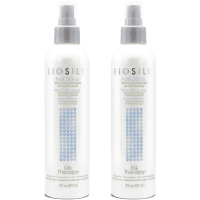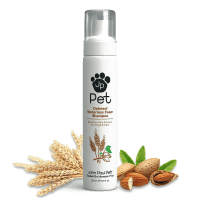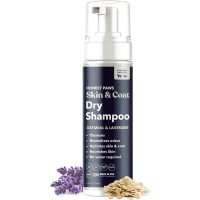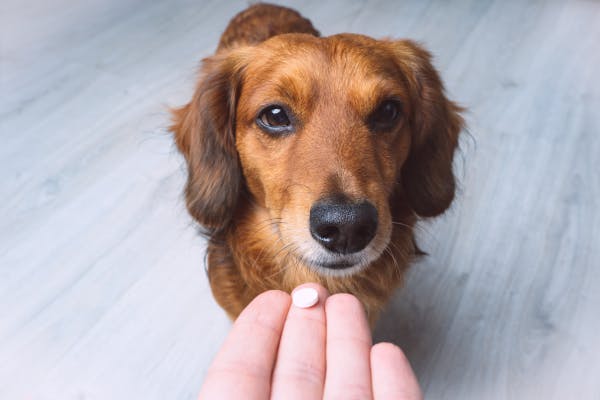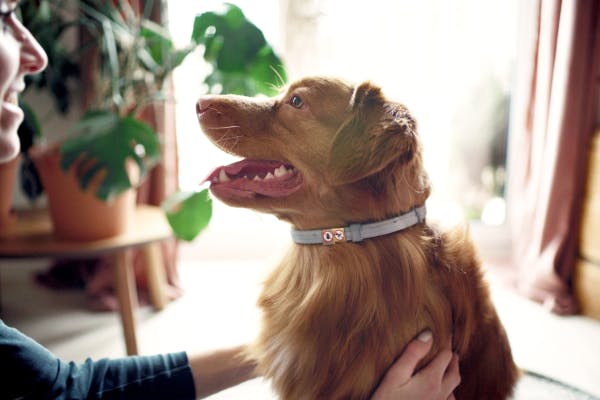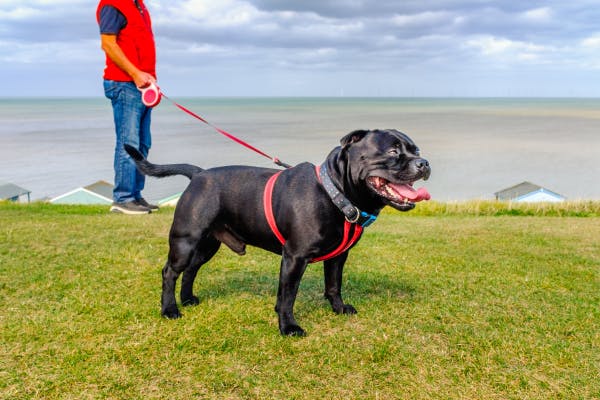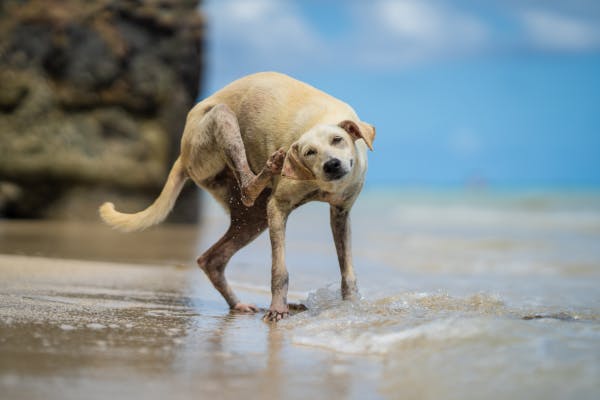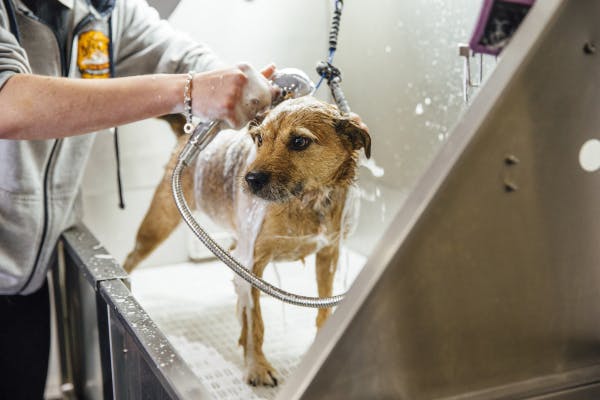learn about dry dog shampoo
Dry Dog Shampoo: How it Works, Advantages, Disadvantages and Safety
Dry dog shampoo is a handy way to keep dogs clean, especially when you can't give them a bath. It soaks up extra oils and dirt from their fur, making it cleaner and smell better. But, it doesn't take the place of normal baths because it doesn't clean deeply. Using it too much can cause your dog's skin to dry out and become irritated.

Dry dog shampoo is getting more popular with pet owners because it's easy and convenient to use. It works by soaking up extra oils and dirt from your dog's fur. You can then brush these out easily, leaving your pet's coat clean and smelling good. While dry shampoos do have benefits like reducing shedding or helping with itchy skin, they're not meant to take the place of regular baths. Instead, they should be used as needed in addition to normal bathing.
Understanding Dry Dog Shampoo and How it Works
Dry dog shampoo is a product that cleans your dog without water. It removes dirt and extra oil from your dog's skin and hair. This is different from regular shampoo that needs water.
Dry shampoos clean by soaking up the oils and dirt from your dog's hair. The powders in the shampoo stick to the oils and dirt, making them easy to brush out. But, dry shampoos are not meant to replace baths. They should be used between baths or when you don't have time for a full bath.
Benefits of Dry Shampoos
Dry shampoos are good for dogs because:
They keep your dog clean and smelling good between baths.
They are easy to use.
They can be good for dogs with sensitive skin or allergies.
They can help stop shedding by sticking to loose hair.
They are good for travel, making it easy to keep your dog clean.
Uses of Dog Dry Shampoo
You can use dry shampoo for dogs in many ways:
Use it if your dog smells bad.
Use it when you're not at home and can't bathe your dog.
Use it to help itchy skin in dogs.
Use it after surgery or when your dog is sick and can't take a bath.
Directions For Using Dry Dog Shampoos
To use dry shampoo on your dog, do these steps:
Cover your dog's body with the dry shampoo, including their legs, belly, and chest but avoid their eyes, ears, nose, and any open wounds.
Let the shampoo sit for a few minutes so it can soak up oils and dirt.
Brush the dry shampoo off your dog's hair using a comb if needed.
Give them a treat as a reward.
When buying dry shampoos think about things like pH level which should be neutral so as not to hurt or dry out your dog's skin; natural ingredients over harsh chemicals; avoiding fake smells which can cause irritation; and price which can vary widely.
Is Dry Shampoo Safe for Dogs? Risks and Things to Think About
Dry shampoo for dogs is a product that many dog owners use when they want a fast and easy way to make their pet's coat smell better. But, dry shampoo might seem like a magic answer for busy dog owners, there are some risks and things to think about.
One of the main worries with using dry shampoo on dogs is the chance for skin problems. Dry shampoos work by soaking up oils and dirt from the fur, but they can also soak up needed oils that keep a dog's skin healthy. Using too much dry shampoo can cause dryness, itching, and other skin problems.
Another worry is the chance of eating it. Dogs often lick their fur and if they eat the dry shampoo, it could possibly cause stomach problems or poison them, depending on what's in the product.
Also, while dry shampoo can help lessen smells and make it look like a clean coat, it does not actually clean the skin or fur like water and regular dog shampoo do. This means that germs, bugs, and other possible health risks may still be there even after using dry shampoo.
When thinking about using dry shampoo on dogs:
Always check what's in it: Look for natural things as fake ones can cause problems or other health issues.
Don't use too much: Dry shampoos should not take the place of regular baths but rather be used between them.
Stay away from sensitive areas: Be careful not to get dry shampoo in your dog's eyes or nose as this can cause problems.
Brush well after use: This helps get rid of any leftover stuff from the coat.
So while dry shampoos can be an easy choice for making your dog's coat smell better between baths, they should not be used instead of regular bathing and grooming habits. It's always important to talk with your vet before using any new products in your pet's grooming routine.
Taking care of your dog means using safe products for their skin, coat, and health. But many dog shampoos have harmful ingredients that can hurt your pet. Here are some bad ingredients you should not use in dry dog shampoo:
Formaldehyde: This is a chemical often used to keep pet grooming products fresh. It can make your dog's skin blister, dry out and itch a lot.
Isopropyl Alcohol: This is also called rubbing alcohol. It can make skin more open, letting other bad ingredients soak into your dogs' skin.
Cocamide MEA: This ingredient makes shampoos thick and foamy but comes from a fake chemical called monoethanolamide (MEA). This can be irritating and harsh.
Ethanolamine Compounds: Diethanolamine (DEA) and Triethanolamine (TEA) have been connected to liver cancer and organ damage.
Parabens: These are used to keep things fresh and can build up inside the body over time. They can lead to cancer, problems with reproduction and mess with estrogen.
Phthalates: These chemicals are used in grooming products to help the smell stick but they mess with hormones which can cause big problems for your dog's endocrine system.
Polyethylene Glycol (PEG) & Propylene Glycol (PPG): PEG is used to help keep moisture but it helps other bad chemicals get into your dog's bloodstream. PPG makes skin more open, letting toxic things reach your dogs bloodstream.
Sulfates: These chemicals act as foaming agents or emulsifiers that clean dirt off of skin but they are very drying and have been connected to cancer.
Synthetic Fragrances: These are often used to hide the smell of chemicals but can have hundreds of separate bad ingredients – none of which have to be listed on the label.
Always read the ingredient list on a dog shampoo bottle because it is important for keeping your pet healthy.
best dry dog shampoo
- our rating92 out of 100
- our rating91 out of 100
- our rating89 out of 100
Dry Dog Shampoo: Good and Bad Points
Dry dog shampoo is loved by many pet owners. It's easy to use and very handy. But like all things, it has good points and bad points. It's important to think about these before you decide if it's the best choice for your dog.
Good Points of Dry Dog Shampoo
Quick and Easy: Dry dog shampoo is simple to use and takes less time than a normal bath. It's great for when you need to clean your pet fast.
No Water Needed: Dry dog shampoo doesn't need water. This is perfect for dogs who don't like water or when there is no water around.
Less Smelly: Dry shampoo can help get rid of sebum, an oily stuff that makes your dog smell like a dog. By soaking up this extra oil, it can help cut down smells between baths.
Helpful in Some Cases: Dry shampoo can be useful in some cases like when your dog is getting better from surgery or sickness, or when you're on a trip and can't give your dog a bath.
Makes Fur Shine: Some dry shampoos have stuff in them that can make the fur shine more and look fuller.
Bad Points of Dry Dog Shampoo
Can't Replace Normal Baths: Even though dry shampoo can help clean your dog's coat between baths, it should not take the place of regular baths with water and soap which are needed for deep cleaning.
Might Irritate Skin: Using too much dry shampoo might irritate the skin because it could soak up more than just extra oils, possibly messing up your dog's natural germ-fighting barrier and leading to blocked hair holes.
Build-up Might Happen: If you keep using it without washing properly, build-up could happen on the skin and coat which might cause discomfort or skin problems over time.
Not Good for All Dogs: Dogs with certain skin problems or allergies might have bad reactions to some stuff in dry shampoos.
Might Not Get Rid of All Dirt or Smells: While dry shampoos can soak up oil and cut down smells, they might not be as good at getting rid of all dirt or strong smells compared with normal bathing methods.
While dry shampoos have many good points like being handy and controlling smells fast, they should not take the place of regular baths which give a deep clean needed for keeping your pet healthy overall. Always ask your vet if you're not sure about any grooming products for your pet.
Safe Use of Dry Dog Shampoo
Dry dog shampoo is a handy tool for keeping your dog clean, especially when you can't give them a regular bath. But it's important to use dry shampoo in the right way to keep your pet safe and comfortable. Here are some tips:
Pick the Right Product
When you're picking out a dry dog shampoo, make sure to get one that is made for dogs. These shampoos are made with safe, natural ingredients that won't hurt your pet's skin or fur. Good ingredients to look for are chamomile, coconut, aloe vera, oats, and lavender essential oil. These can help keep your pet's fur healthy and hydrated.
Test it Out First
Before you use the dry shampoo on your dog for the first time, do a patch test. Put a little bit of the product on a small part of your pet's skin and watch for any bad reactions like redness or itching. If there are no bad reactions, it should be safe to use.
Don't Overuse It
Dry shampoo is great for freshening up your dog between baths, but it shouldn't replace regular baths with water and soap. Regular baths do a better job of cleaning dirt and grease out of your pet's fur.
You should give your dog a normal bath after every four times you use dry shampoo. Also think about things like how patient your pet is during baths and any health problems they have when deciding how often to use dry shampoo.
Use It Right
When you're putting dry shampoo on your dog, don't use too much at once because this can make their skin and fur too dry. Instead, put on just enough to cover their coat evenly.
Think About Your Dog’s Health
Dry shampoos can be really helpful for dogs with certain health problems like sensitive skin or allergies. They might also be good to use after surgery or an injury when regular baths aren't recommended.
No matter how you decide to use dry shampoos in your dog’s grooming routine always talk with a professional before starting any new products in their care routine.
